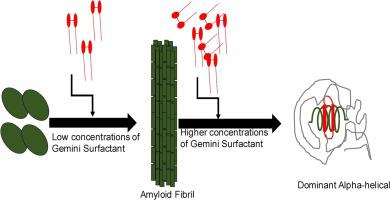当前位置:
X-MOL 学术
›
Colloids Surf. A Physicochem. Eng. Aspects
›
论文详情
Our official English website, www.x-mol.net, welcomes your feedback! (Note: you will need to create a separate account there.)
Industrially important enzyme bovine liver catalase forms reversible amyloid in the presence of 14-4-14 Gemini surfactant at physiological pH
Colloids and Surfaces A: Physicochemical and Engineering Aspects ( IF 5.2 ) Pub Date : 2021-02-01 , DOI: 10.1016/j.colsurfa.2020.125909 Javed Masood Khan , Priyankar Sen , Ajamaluddin Malik , Md. Tabish Rehman , Mohamed F. AlAjmi , Anwar Ahmed , Osama Hamdan Ali Alghamdi , Aqeel Ahmad , Mohammad Z. Ahmed , Rizwan Hasan Khan , Md. Khalid Anwer
Colloids and Surfaces A: Physicochemical and Engineering Aspects ( IF 5.2 ) Pub Date : 2021-02-01 , DOI: 10.1016/j.colsurfa.2020.125909 Javed Masood Khan , Priyankar Sen , Ajamaluddin Malik , Md. Tabish Rehman , Mohamed F. AlAjmi , Anwar Ahmed , Osama Hamdan Ali Alghamdi , Aqeel Ahmad , Mohammad Z. Ahmed , Rizwan Hasan Khan , Md. Khalid Anwer

|
Abstract Bovine liver catalase (BLC), a homotetramer (Mr = 28,000), is an industrially and pharmaceutically important enzyme. A cationic Gemini surfactant (tetramethylene-1,4-bis(dimethyltetradecylammonium bromide); 14-4-14) was found to induce aggregation in BLC, as confirmed by Rayleigh light scattering and dynamic light scattering up to ∼150 µM, at a critical micellar concentration (CMC) at physiological pH. On further increasing, the Gemini concentration aggregate disappeared. Secondary and tertiary structural studies confirmed that BLC structure perturbation occurs in two phases: first, loss of both secondary and tertiary structures till the CMC of 14-4-14; and second, recovery of the secondary structure above the CMC, unlike the tertiary structure that showed further solvent accessibility of tryptophan residues, which resulted in unfolding. Moreover, 14-4-14 may have unfolded the enzyme by either directly interacting or opening the hydrophobic patches or engineering solvent shells and reversibly disrupting helical structures until the concentration reaches the CMC. However, above the CMC, with the probable steric hindrance in 14-4-14 active groups due to polymerization, the BLC secondary structure recovered. The thioflavin T fluorescence and transmission electron microscopy results showed that the aggregates were amyloid in nature. Molecular docking analysis also confirmed that 14-4-14 interacted with BLC mainly through hydrophobic interactions, along with a minor contribution of electrostatic interactions. Thus, this study showed how to reverse the surfactant induced BLC amyloid at physiological pH and 298 K, which could be exploited industrially.
中文翻译:

工业上重要的酶牛肝过氧化氢酶在生理 pH 值下在 14-4-14 Gemini 表面活性剂存在下形成可逆淀粉样蛋白
摘要 牛肝过氧化氢酶 (BLC) 是一种同源四聚体 (Mr = 28,000),是一种重要的工业和药学酶。发现阳离子 Gemini 表面活性剂(四亚甲基-1,4-双(二甲基十四烷基溴化铵);14-4-14)在 BLC 中诱导聚集,瑞利光散射和动态光散射高达 ~150 µM,在临界生理 pH 值下的胶束浓度 (CMC)。随着进一步增加,Gemini 浓度聚集体消失了。二级和三级结构研究证实,BLC 结构扰动发生在两个阶段:首先,二级和三级结构都丢失,直到 14-4-14 的 CMC;其次,恢复了 CMC 上方的二级结构,这与显示色氨酸残基进一步溶剂可及性的三级结构不同,这导致展开。此外,14-4-14 可能通过直接相互作用或打开疏水斑块或工程溶剂壳并可逆地破坏螺旋结构直到浓度达到 CMC 来展开酶。然而,在 CMC 之上,由于聚合可能在 14-4-14 活性基团中出现位阻,BLC 二级结构恢复。硫代黄素 T 荧光和透射电子显微镜结果表明聚集体是淀粉样蛋白。分子对接分析还证实,14-4-14 主要通过疏水相互作用与 BLC 相互作用,静电相互作用的贡献很小。因此,本研究展示了如何在生理 pH 值和 298 K 下逆转表面活性剂诱导的 BLC 淀粉样蛋白,这可以在工业上加以利用。14-4-14 可能通过直接相互作用或打开疏水性斑块或工程溶剂壳并可逆地破坏螺旋结构直到浓度达到 CMC 来展开酶。然而,在 CMC 之上,由于聚合可能在 14-4-14 活性基团中出现位阻,BLC 二级结构恢复。硫代黄素 T 荧光和透射电子显微镜结果表明聚集体是淀粉样蛋白。分子对接分析还证实,14-4-14 主要通过疏水相互作用与 BLC 相互作用,静电相互作用的贡献很小。因此,本研究展示了如何在生理 pH 值和 298 K 下逆转表面活性剂诱导的 BLC 淀粉样蛋白,这可以在工业上加以利用。14-4-14 可能通过直接相互作用或打开疏水性斑块或工程溶剂壳并可逆地破坏螺旋结构直到浓度达到 CMC 来展开酶。然而,在 CMC 之上,由于聚合可能在 14-4-14 活性基团中出现位阻,BLC 二级结构恢复。硫代黄素 T 荧光和透射电子显微镜结果表明聚集体是淀粉样蛋白。分子对接分析还证实,14-4-14 主要通过疏水相互作用与 BLC 相互作用,静电相互作用的贡献很小。因此,本研究展示了如何在生理 pH 值和 298 K 下逆转表面活性剂诱导的 BLC 淀粉样蛋白,这可以在工业上加以利用。
更新日期:2021-02-01
中文翻译:

工业上重要的酶牛肝过氧化氢酶在生理 pH 值下在 14-4-14 Gemini 表面活性剂存在下形成可逆淀粉样蛋白
摘要 牛肝过氧化氢酶 (BLC) 是一种同源四聚体 (Mr = 28,000),是一种重要的工业和药学酶。发现阳离子 Gemini 表面活性剂(四亚甲基-1,4-双(二甲基十四烷基溴化铵);14-4-14)在 BLC 中诱导聚集,瑞利光散射和动态光散射高达 ~150 µM,在临界生理 pH 值下的胶束浓度 (CMC)。随着进一步增加,Gemini 浓度聚集体消失了。二级和三级结构研究证实,BLC 结构扰动发生在两个阶段:首先,二级和三级结构都丢失,直到 14-4-14 的 CMC;其次,恢复了 CMC 上方的二级结构,这与显示色氨酸残基进一步溶剂可及性的三级结构不同,这导致展开。此外,14-4-14 可能通过直接相互作用或打开疏水斑块或工程溶剂壳并可逆地破坏螺旋结构直到浓度达到 CMC 来展开酶。然而,在 CMC 之上,由于聚合可能在 14-4-14 活性基团中出现位阻,BLC 二级结构恢复。硫代黄素 T 荧光和透射电子显微镜结果表明聚集体是淀粉样蛋白。分子对接分析还证实,14-4-14 主要通过疏水相互作用与 BLC 相互作用,静电相互作用的贡献很小。因此,本研究展示了如何在生理 pH 值和 298 K 下逆转表面活性剂诱导的 BLC 淀粉样蛋白,这可以在工业上加以利用。14-4-14 可能通过直接相互作用或打开疏水性斑块或工程溶剂壳并可逆地破坏螺旋结构直到浓度达到 CMC 来展开酶。然而,在 CMC 之上,由于聚合可能在 14-4-14 活性基团中出现位阻,BLC 二级结构恢复。硫代黄素 T 荧光和透射电子显微镜结果表明聚集体是淀粉样蛋白。分子对接分析还证实,14-4-14 主要通过疏水相互作用与 BLC 相互作用,静电相互作用的贡献很小。因此,本研究展示了如何在生理 pH 值和 298 K 下逆转表面活性剂诱导的 BLC 淀粉样蛋白,这可以在工业上加以利用。14-4-14 可能通过直接相互作用或打开疏水性斑块或工程溶剂壳并可逆地破坏螺旋结构直到浓度达到 CMC 来展开酶。然而,在 CMC 之上,由于聚合可能在 14-4-14 活性基团中出现位阻,BLC 二级结构恢复。硫代黄素 T 荧光和透射电子显微镜结果表明聚集体是淀粉样蛋白。分子对接分析还证实,14-4-14 主要通过疏水相互作用与 BLC 相互作用,静电相互作用的贡献很小。因此,本研究展示了如何在生理 pH 值和 298 K 下逆转表面活性剂诱导的 BLC 淀粉样蛋白,这可以在工业上加以利用。



























 京公网安备 11010802027423号
京公网安备 11010802027423号